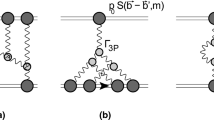The parton model pictures hadrons as a collection of pointlike quasi-free particles. The model describes the cross section for high-energy scattering of hadrons with another particle as an incoherent sum of the cross sections of the pointlike partons in the hadron with the other particle. The hadronic factors in the cross sections are parametrized by “structure functions.” The parton model expresses the structure functions in terms of parton distribution functions that give the longitudinal momentum distribution of the partons in the given hadron. The parton distribution functions are found from experimental data in a given process and are used in the description of other processes (Fig. 1).
Access this chapter
Tax calculation will be finalised at checkout
Purchases are for personal use only
Preview
Unable to display preview. Download preview PDF.
Similar content being viewed by others
Primary Literature
J.D. Bjorken: Asymptotic Sum Rules at Infinite Momentum. Phys. Rev. 179, 1527–1553 (1969).
R.P. Feynman: Very High-Energy Collisions of Hadrons. Phys. Rev. Lett. 23, 1415–1417 (1969); The behavior of hadron collisions at extreme energies, in Stony Brook 1969, Proceedings, Conference On High Energy Collisions, ed. C.N. Yang, et al, (Gordon and Breach, New York 1969), 237–258. The word parton first appears here.
J.D. Bjorken and E.A. Paschos: Inelastic Electron-Proton and γ -Proton Scattering and the Structure of the Nucleon. Phys. Rev. 185, 1975–1982 (1969).
J.D. Bjorken and E.A. Paschos: High-Energy Inelastic Neutrino-Nucleon Interactions. Phys. Rev. D 1, 3151–3160 (1970).
C.G. Callan, Jr. and D.J. Gross: High-Energy Electroproduction and the Constitution of the Electric Current. Phys. Rev. Lett. 22, 156–159 (1969).
R.E. Taylor: Deep inelastic scattering: The early years. Rev. Mod. Phys. 63, 573–595 (1991); H.W. Kendall: Deep inelastic scattering: Experiments on the proton and the observation of scaling. Rev. Mod. Phys. 63, 597–614 (1991); J.I. Friedman: Deep inelastic scattering: Comparisons with the quark model. Rev. Mod. Phys. 63, 615–627 (1991).
P.M. Nadolsky, et. al.: Implications of CTEQ global analysis for collider observables. arXiv 0802.0007.
J. Blumlein, H. Bottcher and A. Guffanti: Non-Singlet QCD Analysis of Deep Inelastic World Data at O(α(s)3). Nucl. Phys. B 774, 182–207 (2007).
A.J. Buras: Asymptotic Freedom in Deep Inelastic Processes in the Leading Order and Beyond. Rev. Mod. Phys. 52, 199–276 (1980).
C. Bourrely and J. Soffer: Deep inelastic scattering of leptons and hadrons in the QCD parton model and experimental tests. in Scattering and Inverse Scattering in Pure and Applied Science. ed. E.R. Pike and Pierre Sabatier. (Academic, New York 2001) pp. 1565–1581.
E.D. Bloom and F. Gilman: Scaling, Duality, and the Behavior of Resonances in Inelastic Electron-Proton Scattering. Phys. Rev. Lett. 25, 1140 (1970).
S.D. Drell and T.-M. Yan: Partons and Their Applications at High Energies. Ann. Phys. (NY) 66, 578 (1971).
R.P. Feynman, Photon-Hadron Interactions, (Benjamin, Reading 1972)
D.J. Gross and F. Wilczek: Asymptotically Free Gauge Theories. 1. Phys. Rev. D 8, 3633–3652 (1973); and 2. Phys. Rev. D 9, 980–993 (1974).
H. Georgi and H.D. Politzer: Electroproduction Scaling in an Asymptotically Free Theory of Strong Interactions. Phys. Rev. D 9, 416–420 (1974).
Yu.L. Dokshitzer: Calculation of the Structure Functions for Deep Inelastic Scattering and e+ e− Annihilation by Perturbation Theory in Quantum Chromodynamics. Sov. J. JETP 46, 641–653 (1977); V.N. Gribov and L.N. Lipatov: e+ e− Pair Annihilation and Deep Inelastic e p Scattering in Perturbation Theory. Sov. J. Nucl. Phys. 15, 438–450 (1972) and Deep inelastic e p scattering in perturbation theory. Sov. J. Nucl. Phys. 15, 438–450 (1972); and G. Alteralli and G. Parisi: Asymptotic Freedom in Parton Language. Nucl. Phys. B 126, 298–318 (1977).
J. Ashman, et al: An investigation of the spin structure of the proton in deep inelastic scattering of polarised muons on polarised protons. Nucl. Phys. B 328, 1–35 (1989).
S.J. Brodsky, J. Ellis and M. Karliner: Chiral Symmetry and the Spin of the Proton. Phys. Lett. B 206, 309–315 (1988) and J. Ellis and M. Karliner: An Analysis of the Angular Momentum of the Proton. Phys. Lett. B 213, 73–80 (1988).
X. Ji: The Spin of the Proton: Looking Back and Looking Forward. AIP Conf Proc. 915, 16–21 (2007); and Generalized Parton Distributions. Annu. Rev. Nucl. Part. Sci. 54, 413–450 (2004).
D.J. Gross and F. Wilczek: Ultraviolet Behavior of Non-Abelian Gauge Theories. Phys. Rev. Lett. 30, 1343–1346 (1973).
Secondary Literature
H.D. Politzer: Reliable Perturbative Results for Strong Interactions? Phys. Rev. Lett. 30, 1346–1349 (1973).
F.E. Close, An Introduction to Quarks and Partons, (Academic, London, 1980).
F. Halzen and A.D. Martin, Quarks & Leptons, (Wiley, New York, 1984).
D.H. Perkins, Introduction to High Energy Physics, (Addison-Wesley, London, 1987).
M. Riordan: The Hunting of the Quark, (Simon & Schuster, New York, 1987).
Editor information
Editors and Affiliations
Rights and permissions
Copyright information
© 2009 Springer-Verlag Berlin Heidelberg
About this chapter
Cite this chapter
Greenberg, O.W. (2009). Parton Model. In: Greenberger, D., Hentschel, K., Weinert, F. (eds) Compendium of Quantum Physics. Springer, Berlin, Heidelberg. https://doi.org/10.1007/978-3-540-70626-7_139
Download citation
DOI: https://doi.org/10.1007/978-3-540-70626-7_139
Published:
Publisher Name: Springer, Berlin, Heidelberg
Print ISBN: 978-3-540-70622-9
Online ISBN: 978-3-540-70626-7
eBook Packages: Physics and AstronomyPhysics and Astronomy (R0)




